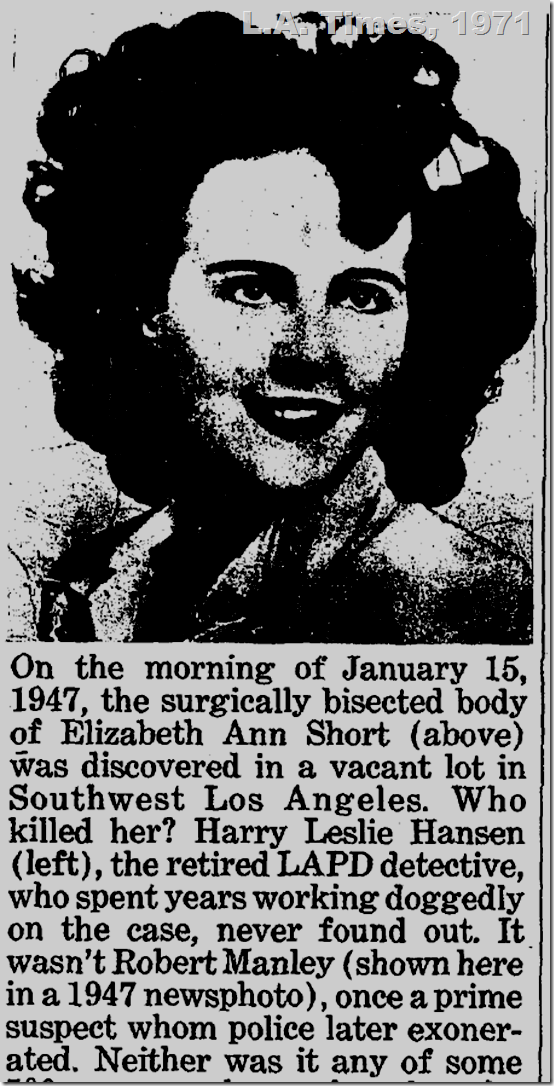
Here are six reasons Dr. George Hodel did not kill Elizabeth Short that you will need to know before watching the TNT mini-series “I Am the Night” or listening to the eight-part podcast accompanying the production.
Reason No. 1: Dr. George Hodel was never “the prime suspect” or even “a prime suspect” in the Black Dahlia case.
Steve Hodel perpetually claims that his father was “the prime suspect” in the Black Dahlia case. This is a curious view in that Steve Hodel also says he never knew that his father was investigated in the murder.
To put the question in context, the LAPD considered everyone who ever had contact with Elizabeth Short to be a suspect, so there were hundreds of “suspects” who had to be eliminated. Also understand that there is nothing to show Dr. George Hodel and Elizabeth Short ever had contact (more about that later).
Dr. George Hodel was never publicly linked to the Black Dahlia case, not by the LAPD or by the newspapers, which covered the arrest or detention of every potential suspect.
The first person to publicly link Dr. George Hodel and the Black Dahlia case was the late Janice Knowlton (“Daddy Was the Black Dahlia Killer,”) posting on an Internet bulletin board Aug. 8, 1998, before Hodel’s death in 1999 and before publication of Steve Hodel’s “Black Dahlia Avenger” in 2003. Knowlton committed suicide the next year.

In truth, only one man was publicly identified as “a prime suspect” in the Black Dahlia case and that was Robert M. “Red” Manley, the traveling salesman who brought Elizabeth Short from San Diego to Los Angeles in January 1947, and he was cleared. The term occurs in the problematic March 28, 1971, article on the Black Dahlia case in the Los Angeles Times. Notice that The Times introduced the erroneous middle name “Ann,” which has permeated Black Dahlia material. Elizabeth Short had no middle name.
Besides Manley, there were two other main suspects: Cpl. Joseph Dumais (false confessor) and Leslie Dillon (cleared). One could argue that they were also “prime suspects.” But nobody else.


The term “prime suspect” in the Black Dahlia case appears one other time and that’s April 1, 1950, several days after the LAPD abandoned its surveillance of George Hodel’s home for lack of interest (March 27, 1950).
The George Hodel files Part 1 | Part 2 | Part 3 | Part 4 | Part 5 | Part 6 | Part 7 | Part 8 | Part 9 | Part 10 | Part 11 | Part 12 | Part 13 | Part 14 | Part 15 | Part 16 | Part 17 | Part 18 | Part 19 | Part 20 | Part 21 |Part 22 | Part 23 | Part 24 | Part 25 | Part 26 | Part 27 | Part 28 | Part 29 | Part 30 | Part 31 | Part 32 | Part 33 | Part 34 | Part 35 | Part 36 | Part 37

The Times said: District attorney’s investigators Walter Morgan and Frank Jemison “declined to name the man they are seeking as the prime suspect, but indicated that he is the owner of the mysterious bloody clothing which has disappeared from police evidence lockers.”
After the Black Dahlia killing, many pieces of bloody clothing and other objects were turned over to investigators. Every item was found to be unrelated to the case.
Was Dr. George Hodel a “prime suspect?” No.
To be continued.


Great work!
LikeLike
If he wasn’t a suspect why did the LAPD plant listening devices in his home? And what do you make of the transcripts of those recordings?
LikeLike
Dear Comcast Cable Subscriber in Portland, Ore.
Let’s unpack your question a bit.
Was George Hodel, as Steve Hodel says, “the prime suspect?” As in THE prime suspect?
First of all, no. Nobody was ever THE prime suspect. There were a few people who could be considered A prime suspect.
They would be Red Manley (cleared), Joseph Dumais (bogus confession) and Leslie Dillon (cleared, though you may hear otherwise).
So why did the police look at George Hodel?
In performing the autopsy, the medical examiner, Dr. Frederick Newbarr, determined that whoever cut Elizabeth Short in half had extensive surgical skill.
As a result, investigators looked at anybody 1) who had some sort of medical background and 2) had been accused of a sex crime.
The police looked at physical therapists, chiropractors, osteopaths, medical students, dental students, and I think there may have been a masseuse or two.
The most accurate term for George Hodel would be “a person of interest” because he had a medical background and he had been accused (and found not guilty) of a sex crime.
The LAPD did bug his house — but in doing so, disproved the idea that he was so powerful that the police and other officials covered up the killing. If George Hodel had really been that powerful, the LAPD couldn’t have bugged him at all, right? You can’t have it both ways, although Steve Hodel tries to do exactly that.
The transcripts are boring (and they are all on this website if you care to read them). George Hodel wasn’t stupid. He knew he was being bugged and so he said inflammatory things to see if he could get a reaction out of the police who were listening to him.
And by March 1950, the police lost any interest in him because the surveillance established nothing.
And that is really the end of the George Hodel story.
Until after he died, then Steve Hodel began writing books about how awful his father was, creating the fictional James Bond villain that you see in “I Am the Night.”
LikeLiked by 1 person